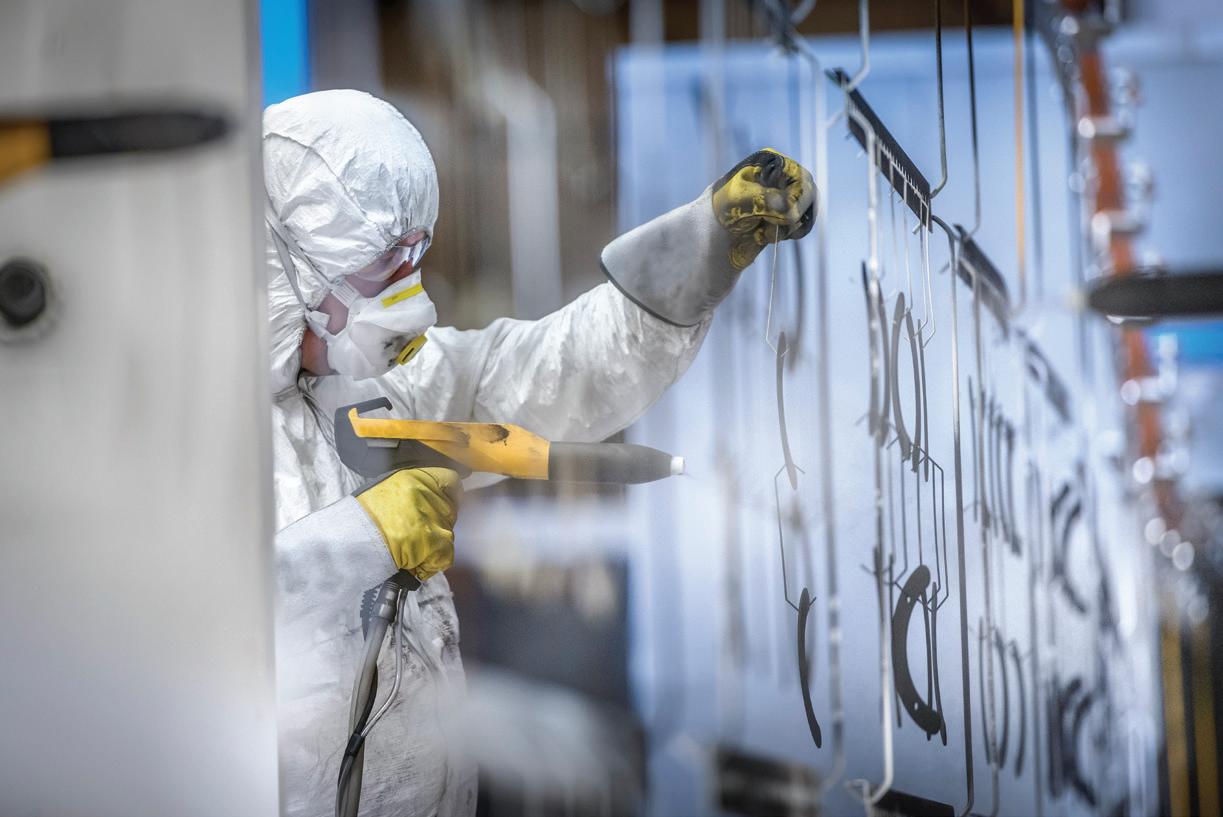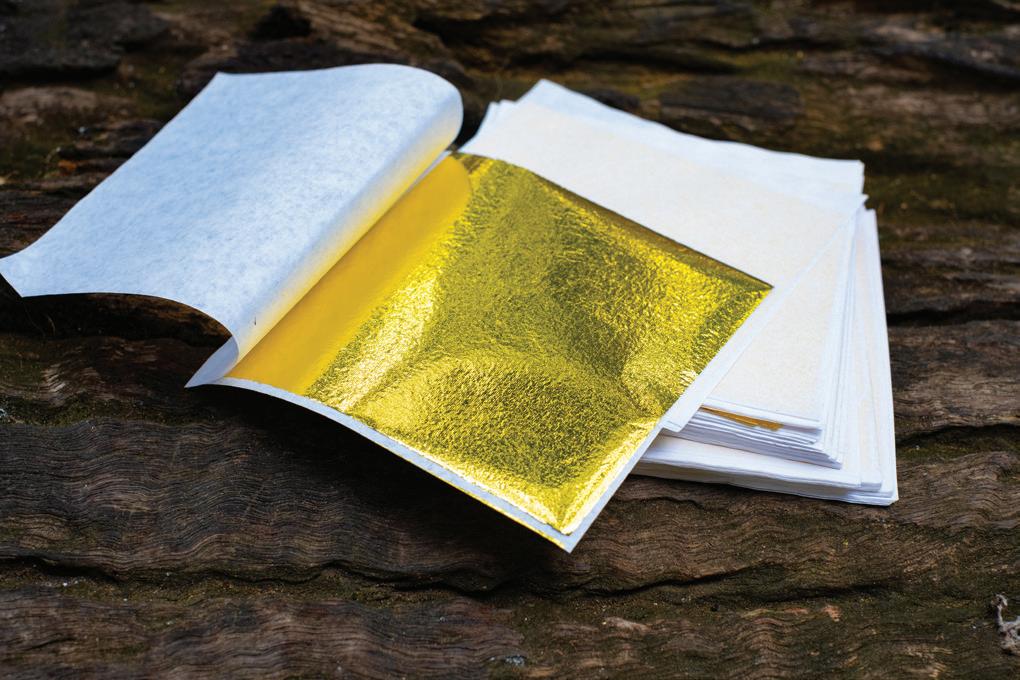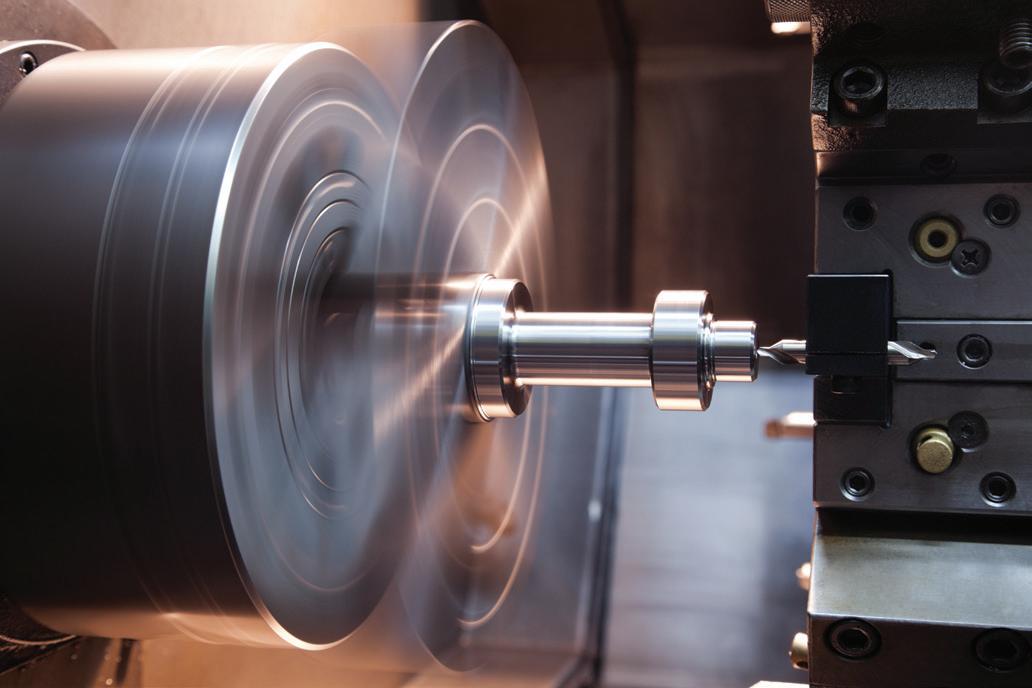
9 minute read
TA2: Design requirements
Finishing processes: Painting and powder coating see p.84
What you need to know
• The tools, equipment, steps and safety measures used in painting and powder coating.
Finishing processes apply a coating to give the fi nal colour to a product and to provide protection against corrosion.
Painting Conventional wet paint contains coloured pigments and binders carried in a water or oilbased solvent. The solvent evaporates into the atmosphere as the paint dries and so must be used in a well-ventilated area. Painting is widely used on a diverse range of materials (for example, metals, polymers, wood, concrete, and so on). Application Paint can be brushed on but a much better surface fi nish is achieved by spraying. Powder coating Powder coating applies a highly durable and protective layer of polymer onto metal components. Application The metal component and dry powder are given opposite electrostatic charges. This causes the fi ne power particles to be attracted to the metal and form an even coat. The coated components move through an oven where the powder particles melt, fuse together and then cure to form a continuous coating.


Paint spraying can achieve a high-quality surface fi nish.DRAFT Fine polymer powders are applied electrostatically before being cured in a baking oven.

Practise it!

State one environmental advantage of using powder coating instead of wet paint spraying. (1 mark)
Remember it!

Finishing processes are used to: • apply colour • provide protection against corrosion.
What you need to know
• The mechanical properties of materials (including their defi nitions).
The behaviour of a material under load (when forces are applied to it) depends largely on its mechanical properties.


Tensile strength
The maximum tensile (pulling) load a material can support without breaking. Compressive strength
The maximum compressive (squeezing) load a material can support without breaking. Yield strength
The maximum load a material can support and still recover its original shape when the load is removed. Materials behave elastically until loaded above their yield strength at which point some permanent stretching will occur. Elasticity
The ability of a material to recover its original shape after being stretched or compressed. Springs depend on the elastic properties of steel to recover their shape. However, they can become permanently stretched (or compressed) or break if they are loaded past their yield strength. A range of tension and compression springs. Ductility
The ability of a material to be permanently stretched without breaking. High ductility materials like copper can be permanently stretched (drawn) into long wires using loads above their yield strength. Low ductility materials (also known as brittle materials) like glass break almost immediately when loaded above their yield strength.



Hardness The ability of a material to resist indentation (dents) or abrasion (scratches and wear). High hardness is often associated with high strength and low ductility (brittleness). High speed steel (HSS) drill bits rely on high hardness and high strength to cut holes in softer DRAFT materials like mild steel.

Practise it! Remember it!

Which of the following best describes the behaviour of a material when loaded below its yield strength? (1 mark) A the material breaks B the material is permanently stretched C the material behaves elastically D the material stretches and then breaks The key material properties to remember are:

Tensile strength Compressive strength Yield strength Elasticity Ductility Hardness
Malleability, machinability, cost and sustainability see p.86
What you need to know
• Other properties of materials that infl uence manufacturing (including their defi nitions).
A range of other properties and characteristics can affect the choice of material used in a given application.


Malleability
The ability of a material to be shaped by pressing or hammering without cracking or breaking. Material cost
The cost of the material stock required to manufacture a component. Engineers use the minimum quantity of material required to perform a task, to minimise material cost. Manufacturing cost
The cost of processing material stock into a fi nished component. Engineers carefully select materials and processes to minimise manufacturing cost.




Machinability How easily a material can be machined (sawn, drilled, turned or milled). Choosing materials with good machinability will make manufacturing easier and reduce manufacturing cost. Sustainability The long term environmental and social impact of the extraction, processing and use of materials. Raw material extraction and industrial processes that cause pollution and contribute to climate Using free cutting steels like EN1A can signifi cantly reduce machining costs. Gold is highly malleable and can be beaten into gold leaf that is only 0.1 µm thick.DRAFT change must be minimised. Recycled and renewable materials should be used whenever possible. Engineers need to consider the long term environmental and social impact of the choices they make to ensure that they are sustainable.



Revise it!

Make a series of fl ash cards and use them to help learn the defi nitions of the properties and characteristics of materials.
Remember it!

Metals: Ferrous metal alloys see p.87
What you need to know
• The properties, typical forms of supply and common applications of ferrous metal alloys.
Pure metals are seldom used in engineering applications. Usually, metals and other elements like carbon are mixed to form metal alloys with enhanced material properties.
Ferrous metal alloys Ferrous metals are alloys that contain iron mixed with small amounts of other alloying elements that change their material properties. Ferrous alloy Properties Example applications
Low carbon (mild) steel – Carbon (0.15–0.30%) • Moderate tensile strength (40 approx. 500 MPa) – higher than most non-ferrous alloys but lower than high carbon steel • Ductile • Cannot be strengthened or hardened using heat treatment • Has poor corrosion resistance and will rust unless coated or painted; good machinability General purpose; widely used in a range of applications, for example, nails, staples, nuts, bolts, washers, car body panels, girders, steel beams
High carbon (tool) steel – Carbon (0.8–1.4%) • High tensile strength (40 approx. 900 MPa) higher than mild steel • Can be strengthened and hardened using heat treatment • Lower ductility than mild steel • Has poor corrosion resistance and so will rust unless coated or painted • Poor machinability Used in applications requiring high hardness, for example, saw blades, hammers, chisels, springs
Cast iron – Carbon (2.0–3.5%) • Low tensile strength (40 approx. 350 MPa) lower than mild steel • Better compressive strength than mild steel • Low ductility (cast iron is brittle) • Has poor corrosion resistance and so will rust easily unless coated or painted • Poor machinability Used extensively for large cast components, for example, engineering vices, machine beds, engine blocks
Stainless steel –
Carbon (< 1.0%) –
Chromium (>11.5%) • Moderate tensile strength (40 approx. 600 MPa) higher than mild steel • THE majority of stainless steels cannot be hardened using heat treatment • Lower ductility than mild steel • High corrosion resistance • Poor machinability • Relatively expensive due to the high cost of alloying metals like chromium
Used in applications requiring high corrosion resistance, for example, cutlery, medical equipment, kitchen sinks, chemical processing, food processingDRAFT
Practise it!

Explain why mild steel is not used for kitchen utensils such as knives and forks. (2 marks)
Remember it!

• The strength and hardness of ferrous metals is infl uenced mainly by their carbon content. • Components made of high carbon steel (containing 0.8–1.4% carbon) can be heat treated to make them much harder.
Metals: Aluminium alloys see p.88
What you need to know
• The properties, typical forms of supply and common applications of non-ferrous metal alloys.
Non-ferrous metal alloys do not contain iron. Many common non-ferrous alloys used in engineering are based on aluminium.
Aluminium alloys
Aluminium alloys contain aluminium mixed with small amounts of other metals that change their material properties. They have much lower tensile strength than even mild steel but are around three times lighter. Aluminium alloys Properties Example applications Aluminium (>99.5% pure) Very low tensile strength (approx. 75–105 MPa); high ductility; low hardness; moderate corrosion resistance; high electrical conductivity Electrical wire and cable Typical general purpose aluminium alloy – Copper (0.12%) – Manganese (1.2%) Low tensile strength (approx. 90–160 MPa); high ductility; low hardness; moderate corrosion resistance; good machinability General purpose, sheet, cooking utensils, containers, pipes Typical structural aluminium alloy – Copper (0.28%) – Silicon (0.6%) – Magnesium (1%) Low/moderate tensile strength (approx. 310 MPa) just over half that of mild steel; moderate/high ductility; low hardness; good corrosion resistance; good machinability
General purpose, structural framework, furniture, ramps, stairs Forms of supply Ferrous and non-ferrous metals are available in a wide range of standard bars, rods, sheets and profi les. Plate Sheet Round bar or rod Square bar Hexagon bar Angle Round tube Rectangular tube Channel DRAFT • Aluminium and its alloys are around three times lighter than steel. • Use the bar, rod, sheet or profi le that is closest to the fi nal size and shape of the component you need to make.
Practise it!

Explain why high strength aluminium alloys are used to construct aircraft even though aluminium has lower tensile strength than steel. (2 marks)
Remember it!








